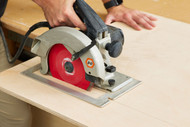Common Mistakes to Avoid When Using Circular Saw Blades for Wood Cutting
Mar 14th 2025
Cutting wood with a circular saw seems straightforward—place the blade, press the trigger, and go. But if you’re a beginner, there are some easy-to-miss mistakes that can lead to rough cuts, damaged blades, or even dangerous situations.
Whether you’re building a DIY project or just starting out in woodworking, avoiding these common pitfalls will save you time, money, and frustration.
1. Using the Wrong Blade for the Job
Not all Circular Saw Blades are the same. If you’re trying to cut plywood, hardwood, or softwood, you need the right blade for each. A fine-tooth blade works great for clean, precise cuts, while a ripping blade with fewer teeth is better for quickly cutting along the grain. Using the wrong one can result in tear-out, burn marks, or even a blade that dulls too quickly.
Fix it: Check the type of blade before starting. Look for blade descriptions like "crosscut," "rip," or "combination" to make sure you’re using the best one for your project.
2. Ignoring Blade Sharpness
A dull blade doesn’t just make cutting harder—it can cause splintering, uneven cuts, and even put extra strain on your saw’s motor. If your saw seems to struggle, leaves burn marks, or requires you to push harder than usual; your blade may be too dull.
Fix it: Inspect the blade before each use. If you notice excessive wear or it’s not cutting smoothly, it’s time to sharpen or replace it.
3. Skipping Safety Gear
It’s tempting to just grab your saw and start cutting, but skipping safety gear is a big mistake. Wood dust and flying debris can cause serious harm. Without proper eye protection, earplugs, or gloves, you could end up with injuries that are easily preventable.
Fix it: Always wear safety glasses, hearing protection, and a dust mask if needed. Gloves are optional but can help you maintain a firm grip on the saw.
4. Not Securing the Wood Properly
If your wood shifts while cutting, your blade can bind, kick back, or produce jagged, imprecise cuts. Holding the wood in place with one hand while sawing with the other might seem fine, but it’s risky and can lead to mistakes.
Fix it: Use clamps or a sawhorse to keep the wood steady. This will make cutting smoother and safer.
5. Cutting Too Fast or Too Slow
Going too fast with your circular saw can cause rough edges and even damage the blade. On the other hand, cutting too slowly can overheat the blade and burn the wood. The key is finding the right pace.
Fix it: Let the saw do the work. Push at a steady, moderate speed—if the blade is struggling or smoking, adjust your pace accordingly.
6. Ignoring the Blade Depth
If the blade is set too deep, it can cause more resistance, increase kickback risk, and wear down faster. If it’s too shallow, it won’t cut properly. A common mistake beginners make is not adjusting the depth at all.
Fix it: Set the blade depth so it extends just ¼ inch below the wood you’re cutting. This helps with control and reduces strain on the saw.
7. Forgetting to Check the Blade Rotation
Believe it or not, some beginners install the blade backward. A circular saw blade should rotate so the teeth face forward (toward the front of the saw). If it’s installed incorrectly, it won’t cut properly and could even be dangerous.
Fix it: Double-check the arrows on the blade and the saw to ensure they are installed correctly before starting.
Get Top Quality Circular Saw Blades Near You
The right circular saw blade can make all the difference in your cuts—cleaner edges, smoother finishes, and less effort on your end.
At The Sharpening House, we provide high-quality circular saw blades designed for precision and durability.
Already have blades but need them sharpened? We provide expert sharpening services to keep your tools performing at their best. Call us at (705) 325-8665 or visit our website to explore our selection and services today!

